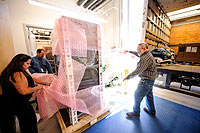ACADEMIA
UW builds Mount Moran supercomputer
The University of Wyoming’s Mount Moran is built and will soon be ready for faculty to ascend new heights. In a manner of supercomputing speak, that is.
The Advanced Research Computing Center (ARCC), nicknamed “Mount Moran” after a mountain in western Wyoming’s Tetons, is a supercomputing center that has drawn the interest of roughly 100 UW faculty and researchers to date. Use of the supercomputing center drew closer to reality with the delivery of the IBM supercomputer system to UW’s Information Technology Center Sept. 14.
After being tested for several weeks in Rochester, Minn., the computer equipment arrived in the late morning, was rolled off a moving truck and transported upstairs for hook-up to individual cooling units -- all in a matter of hours.
Five racks of equipment -- essentially the brains of the high-performance sueprcomputing center -- were unloaded under the careful watch of UW information technology officials.
“The anticipation’s great. We’ve been waiting for this system,” says Tim Kuhfuss, UW’s director of research support for Information Technology.
“This is a big deal. This is nice to get,” says Robert Aylward, UW’s vice president of information technology, as he watched movers negotiate one of the racks off the truck.
The campus cluster will serve two purposes. One, it will enable atmospheric and earth sciences faculty -- who will be able to use the NCAR-Wyoming Supercomputing Center -- to learn what to expect with their software. The cluster provides the opportunity for that group of faculty to work out issues caused by scaling up parallel algorithms from tens or hundreds of processors to thousands of processors, before moving up to tens of thousands of processors on the NWSC supercomputer.
Two, the cluster will provide a research resource for UW research faculty -- such as bioinformaticists, social scientists, pure mathematicians and theoretical physicists -- whose research doesn’t fall within the scope of the NWSC.
Anticipation growing
In June, IBM was chosen to design and build UW’s campus cluster, which will initially use approximately 150 square feet (for five racks of computer equipment) in the university’s IT Center and include roughly 3 percent of the 75,000 CPUs or core hours available to UW at the NWSC. The CPU is essentially the brains of the computer, where most calculations take place.
“There’s faculty with money who want to buy nodes,” Kuhfuss says. “Now that we’re seeing it (campus cluster) getting closer to reality, people are getting interested. This is what I expected.”
Under a condominium model, the university will provide the foundational infrastructure -- personnel to run it, networking and the computer architecture to keep it running -- for the campus cluster. In exchange, UW researchers will purchase computing nodes (computers) or storage. That investment will come from faculty securing successful grant proposals, which are expected to include a request for funding for the computational resources needed for their particular research projects.
First things first
Before UW professors are off and running, some nuts-and-bolts work still has to take place in the next month or so. An IBM engineer is onsite this week to make sure all the computer cabling is installed correctly, says Jeff Lang, a UW high-performance computing architect and administrator, who will handle on site day-to-day operations of the ARCC.
“On Sept. 24, we hope to have a technician here to power it up and customize the installation to our network,” Lang says. “We want to get it set up so that it interacts with our (technology) environment on campus.”
After that step is finished, Lang says the ARCC will go through a testing and verification stage. When that is complete, a few initial users will be selected to conduct “pre-production tests.” Faculty will likely be chosen from engineering, geophysics and math to essentially take a test run of the system, he says.
During October, Mount Moran will be open for a “free period,” meaning researchers can access and try out the system without having to purchase computer nodes, Kuhfuss says.
“My hope is to have it (Mount Moran) in production by Halloween. Then, it becomes a big game of Tetris to get everyone on there,” says Kuhfuss in reference to a popular tabletop strategy game.
There will be an organized resource allocation system created for Mount Moran, Tim Brewer, UW’s end user support manager of research support for information technology, said previously.
“We want to encourage researchers to start here (with their research) and then move up to the supercomputer,” Kuhfuss says.
NCAR officials are currently testing the supercomputer and readying it for the NWSC open house, scheduled noon-4 p.m. Monday, Oct. 15 in the North Range Business Park in Cheyenne. The NWSC also will include an interactive visitors’ center, which will be unveiled at the open house.
